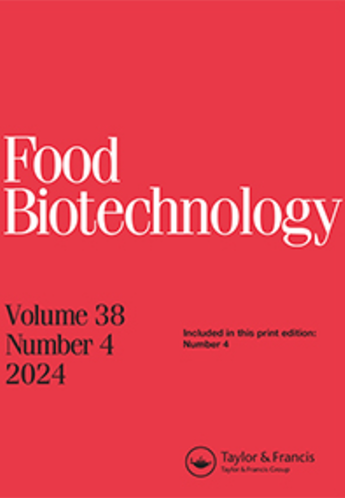墨西哥酒精饮料sotol生产过程中的微生物和化学变化
IF 1.6
4区 农林科学
Q4 BIOTECHNOLOGY & APPLIED MICROBIOLOGY
引用次数: 1
摘要
Sotol是一种由Sotol植物(Dasylirion spp)自发发酵而成的酒精饮料,通常被称为菠萝。然而,在发酵过程中涉及的微生物和化学变化是未知的。本研究的目的是通过PCR、PCR- dgge、16S和18S核糖体基因测序,鉴定发酵过程中涉及的可培养和不可培养微生物,并确定整个发酵过程中发生的化学变化。结果表明,在发酵过程中存在28种微生物,分别为芽孢杆菌属、乳酸菌属、克卢维菌属和毕赤酵母属,种类丰富度主要发生在干发酵阶段。发酵第7天,消耗总糖的80%。而在发酵第10天,总糖消耗量最高(96%),乙醇浓度最高(9.5% v/v)。在这一发酵阶段,分离出的微生物大部分属于乳杆菌属、芽孢杆菌属和克鲁维菌属。与生产梅斯卡酒和龙舌兰酒一样,在发酵第10天,证实了乙酸异戊酯、异戊醇、柠檬烯和2-苯乙醇等有机化合物的存在。在酒精生产过程中所涉及的微生物和化学变化方面所收集到的知识可以帮助标准化生产过程,以获得消费者所期望的具有感官特征的饮料。本文章由计算机程序翻译,如有差异,请以英文原文为准。
Microbial and chemical changes during the production of sotol: a Mexican alcoholic beverage
ABSTRACT Sotol is an alcoholic beverage obtained after the spontaneous fermentation of the sotol plant (Dasylirion spp), commonly known as a pineapple. However, the microorganisms and chemical changes involved during this fermentation process are unknown. The objectives of this research were to identify the cultivable and non-cultivable microorganisms involved during this fermentation using PCR, PCR-DGGE, and the sequencing of the 16S and 18S ribosomal genes, and to determine the chemical changes that occur throughout the fermentation process. Results showed the presence of 28 microorganisms during the sotol (Dasylirion durangensis) production which corresponded to Bacillus, Lactobacillus, Kluyveromyces and Pichia genera, with the major-species richness, occurring in the dry fermentation stage. On the 7th day of fermentation, 80% of total sugar was consumed. While, on the 10th day of fermentation, the highest (96%) consumption of total sugar and the highest (9.5% v/v) ethanol concentration were observed. During this stage of fermentation, most of the microorganisms isolated belonged to Lactobacillus, Bacillus, and Kluyveromyces genera. Like in the production of mescal and tequila, on the 10th day of fermentation, the presence of organic compounds such as isoamyl acetate, isoamyl alcohol, limonene, and 2-phenylethanol was confirmed. The knowledge gathered about the microorganisms and chemical changes involved during sotol production could help to standardize the process for obtaining a beverage with organoleptic characteristics desirable to consumers.
求助全文
通过发布文献求助,成功后即可免费获取论文全文。
去求助
来源期刊

Food Biotechnology
工程技术-生物工程与应用微生物
CiteScore
3.80
自引率
0.00%
发文量
15
审稿时长
>12 weeks
期刊介绍:
Food Biotechnology is an international, peer-reviewed journal that is focused on current and emerging developments and applications of modern genetics, enzymatic, metabolic and systems-based biochemical processes in food and food-related biological systems. The goal is to help produce and improve foods, food ingredients, and functional foods at the processing stage and beyond agricultural production.
Other areas of strong interest are microbial and fermentation-based metabolic processing to improve foods, food microbiomes for health, metabolic basis for food ingredients with health benefits, molecular and metabolic approaches to functional foods, and biochemical processes for food waste remediation. In addition, articles addressing the topics of modern molecular, metabolic and biochemical approaches to improving food safety and quality are also published.
Researchers in agriculture, food science and nutrition, including food and biotechnology consultants around the world will benefit from the research published in Food Biotechnology. The published research and reviews can be utilized to further educational and research programs and may also be applied to food quality and value added processing challenges, which are continuously evolving and expanding based upon the peer reviewed research conducted and published in the journal.
 求助内容:
求助内容: 应助结果提醒方式:
应助结果提醒方式:


